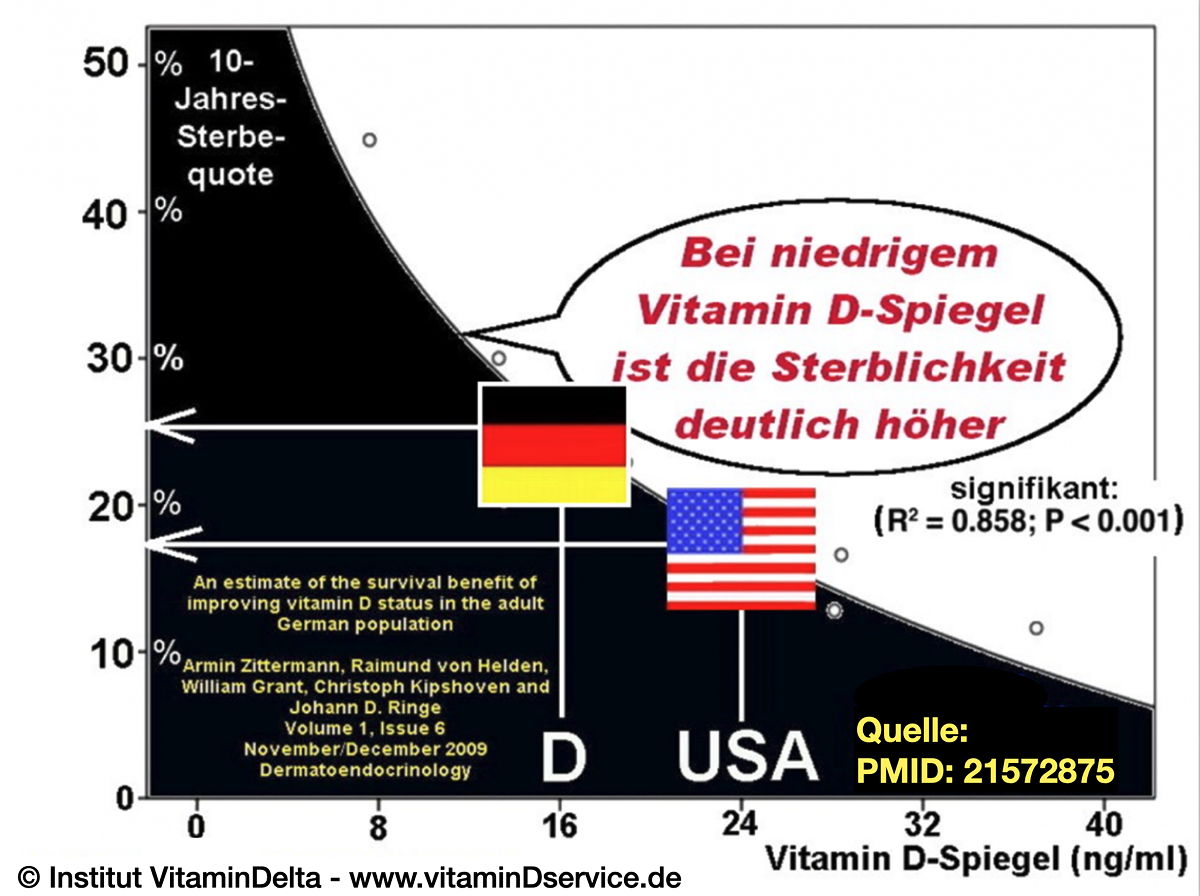| Zittermann Armin, von Helden Raimund., Grant W., Kipshoven C, Ringe JD. 2009-11-05 1) Fragestellung
2) MethodeUnsere Berechnungen basieren auf
3) Ergebnisse
4) Folgerungen
Diesen Beitrag im Video: Quellenangabenengl. Originalfassung: Quelle: Diesen Beitrag im Video: Diese Studie ist wegweisend für die verbesserte Methode der Präsentation im PLOT: Tipps für gutes Design einer Studie: References » Spezielles Download zu diesem Beitrag » Zurück zur VitaminDzeitung als Tabelle » Zum nächsten Beitrag blättern "An estimate of the survival benefit of improving vitamin D status in the adult german population (Meta-Studie)" |  |
- 2014 bis ☀️ ☀️ ☀️ ☀️ ☀️ ✅ ☀️ ☀️ ☀️ ☀️ ☀️ 2024: Wir feiern 10 Jahre VitaminDService - Hier klicken und mehr erfahren!
- ⚙️Symptome
- ⚙️Spiegel
- ☀️ UMRECHNER - Vitamin-D-Spiegel von nmol/l umrechnen in ng/ml
- ☀️Welcher Vitamin-D-SPIEGEL ist normal? (BILDER)
- ☀️ZIEL - wohin soll mein Vitamin-D-Spiegel steigen?
- ☀️ PLOT- die Vitamin-D-AMPEL auf der X-ACHSE
- ☀️25 ng/ml - bessere GEN-STEUERUNG
- ☀️MENSCHENRECHT 30
- ☀️NUTZEN bei 80 ng/ml
- ☀️50 oder 100 ?
- ☀️ 100 ng/ml und mehr - GEFAHR?
- ☀️KREBSSCHUTZ Vitamin D?
- ☀️Was ist NORMAL? (VIDEO)
- ☀️INDEX - Wohin geht der Vitamin-D-Spiegel der Nutzer?
- ☀️KONFETTI - bunte Punkte vom Nutzen des Vitamin D
- ☀️FORSCHUNGSZONE
- ⚙️Rechner
- ⚙️Simulator
- ☀️ ERKLÄR-VIDEO
- ☀️BABY - eine ROSA Kurve zeigt den Vitamin-D-Spiegel
- ☀️KINDER - gratis Vitamin-D-Rechner für Kinder
- ☀️ STUDIE zeigt: Simulator erstellt eine korrekte PROGNOSE
- ☀️SIMULATOR - besser als jeder Vitamin D Rechner
- ☀️ Der SIMULATOR ® ist der Schlüssel zur Steuerung
- ☀️ VitaminDTHERAPIE = Was ist das eigentlich? Hier finden Sie eine anschauliche Definition
- ⚙️VitaminDKonto
- ☀️ERKLÄR-VIDEO: KONTO
- ☀️ Entdecke das www.VitaminDKonto.de
- ☀️so einfach ist das REGISTRIEREN
- ☀️Jetzt zum bereits REGISTRIERTEN Konto
- ☀️ TEAM: 1x Konto eröffnen - 30 Nutzer sind inklusive.
- ☀️TOOLS - unsere Online-Werkzeuge
- ☀️Meine Position im SCHWARM der Nutzer
- ☀️in 60 SEKUNDEN - den Service verstehen
- ☀️ selbst Berater*in werden: Vitamin D UNI .de
- ❤️Beratung
- ❤️ TOP-Klicks
- ❤️ TICKER
- ❤️ Navi
- ❤️ Gratis
- ❤️ Listen
- ☀️ Buch
- ☀️ Erfahrungen
- ☀️ FAQ
- ☀️ Forum
- ☀️Fotos
- ☀️ Fragen-Hitliste
- ☀️ Kongress
- ☀️PRAXIS: Fallberichte
- ☀️WARUM?
- ✅ Hitliste
- ✅ Krankheiten
- ✅ Kritik
- ✅ Mediathek
- ☀️MEDIATHEK - Videos, Bücher, PDF
- ☀️ARMAN ARGUMENTIERT
- ✅Galerie
- ☀️Dr. v.Helden: WIE ich den Vitamin D-Effekt entdeckte
- ☀️BIBLIOTHEK - Bücher zum Vitamin D
- ☀️SCHWANGERSCHAFT- Mediathek
- ☀️KOMPLETTE PALETTE.de - 8 MIN Video.
- ☀️KINDER sind besonders gefährdet
- ☀️ mit GOOGLE suchen
- ☀️ mit ECOSIA suchen
- ✅ YouTube
- ☀️BASISWISSEN-Mediathek
- ☀️ CORONA
- ✅ Mobbing
- ☀️MOBBING = Liste der Fake-News zeigt die Systematik
- ☀️WETTE - Dr. von Helden setzt 4000 Euro
- ☀️NIERENSCHADEN als Vogelscheuche erkennen
- ☀️VERLEUMDUNG - Vitamin D war unschuldig
- ☀️ARZNEIMITTEL-KOMMISSION verbreitet Fehler
- ☀️STREIT - zwischen Ärzten und Wissenschaftlern
- ✅Tools
- ☀️KRITIK am Vitamin D und die Antworten
- ☀️Die Kunst, Lügen zu erkennen
- MÄRCHEN, die töten können!
- Schattenfreund - Ärzte gegen Vitamin D
- ✅ Plot
- ✅ Strategie
- ✅ "Uni"
- ☀️AUSBILDUNG online
- ☀️AKTIVIERUNG - Pfarrer Kneipp hatte recht
- ☀️BEWEISE für den Nutzen des Vitamin D
- ☀️BIBLIOTHEK - Bücher zum Vitamin D
- Die CHRONIK unseres Projektes
- ☀️COIMBRA - Experte für MS
- ☀️FITNESS - was Vitamin D leistet
- ☀️HISTORY - 4000 Jahre Vitamin D
- ☀️HYPOTHESEN
- ☀️KnowHow for your trial
- ☀️NAVI für die Uni
- ✅ Team
- ☀️TOXIZITÄT durch Vitamin D
- ☀️WHO-IS-WHO - unsere Experten
- ✅ Vision
- ☀️ 1 - Paragraf 1 der Ärztlichen Berufsordnung
- ☀️ 4 all - VitaminD4all.de
- ☀️ 30 - Das Menschenrecht auf Vitamin D 30 ng/ml
- ☀️ 66 - VitaminD66 ® - Die "Route 66" zur Freiheit
- ☀️1000 - die 1000 Vorteile des Vitamin D
- ☀️Galileo - Es lebe der Widerspruch!
- ☀️ÜBER die Meilensteine des Projektes
- ☀️VitaminD Zukunft - Was wird Vitamin D noch alles leisten?
- ☀️ Sonne in der Malerei
- ✅ Zeitung
- ⚙️ Lexikon & Glossar
- ⚙️ einfacher
- ⚙️ Support
- ❤️ NaNa10

 ... Privat-Institut-VitaminDelta
... Privat-Institut-VitaminDelta